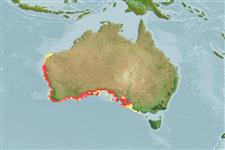Environment: milieu / climate zone / depth range / distribution range
Ökologie
seewasser; brackwasser demersal; standorttreu; tiefenbereich 0 - 30 m (Ref. 6205), usually 0 - 2 m (Ref. 27657). Temperate; 21°S - 39°S, 111°E - 142°E (Ref. 6205)
Eastern Indian Ocean: endemic to Australia, from Dampier to Albany in Western Australia and Gulf St Vincent and Spencer Gulf waters in South Australia. It is not known whether they also occur in the intervening waters.
Length at first maturity / Size / Gewicht / Alter
Maturity: Lm 22.5 range ? - ? cm
Max length : 42.0 cm TL Männchen/unbestimmt; (Ref. 27296); max. veröff. Alter: 12 Jahre (Ref. 27008)
Rückenflossenstacheln (insgesamt): 11 - 13; Rückenflossenweichstrahlen (insgesamt): 19-22; Afterflossenstacheln 2; Afterflossenweichstrahlen: 17 - 20; Wirbelzahl: 37. Its swim bladder is without a median anterior extension.
Generally frequent inshore sand banks, bars, and spits, and congregate in sandy hollows. At high tide they move in schools across the sand flats and retreat to the slopes of the banks when the tide falls. These whiting are principally marine residents (Ref. 27646, 27012), and can tolerate upper Spencer Gulf waters with salinity as high as 40-50 ppt (Ref. 6390). They may also penetrate to the limit of the brackish water in tidal creeks, where salinity is as low as 1 ppt (Ref. 6335, 27012). Juveniles inhabit warmer water, mangrove-lined creeks and inshore protected environments (Ref. 27012) over mud bottoms and seagrass beds (Ref. 6390). The spawning season commences in September and is completed by January in Shark Bay and slightly later along the coast to the south (Ref. 6390). Oviparous (Ref. 205), and are multiple spawners with asynchronous development (Ref. 27656).
Multiple spawners with asynchronous development (Ref. 27656).
McKay, R.J., 1992. FAO Species Catalogue. Vol. 14. Sillaginid fishes of the world (family Sillaginidae). An annotated and illustrated catalogue of the sillago, smelt or Indo-Pacific whiting species known to date. Rome: FAO. FAO Fish. Synop. 125(14):87p. (Ref. 6205)
IUCN Rote Liste Status (Ref. 130435)
Bedrohung für Menschen
Harmless
Nutzung durch Menschen
Fischereien: weniger kommerziell; Aquakultur: zukünftige nutzung; Sportfisch: ja
Mehr Information
ReferenzenAquakulturAquakultur ProfilZuchtlinienGenetikElectrophoresesVererbbarkeitKrankheitenVerarbeitungNutrientsMass conversion
PartnerBilderStamps, Coins Misc.LauteCiguateraGeschwindigkeitSchwimmstilKiemenoberflächeOtolithsGehirngrößeSehfähigkeit
Tools
Zusatzinformationen
Download XML
Internet Quellen
Estimates based on models
Preferred temperature (Ref.
123201): 16 - 23.8, mean 18 °C (based on 175 cells).
Phylogenetic diversity index (Ref.
82804): PD
50 = 0.5000 [Uniqueness, from 0.5 = low to 2.0 = high].
Bayesian length-weight: a=0.00575 (0.00272 - 0.01217), b=3.06 (2.89 - 3.23), in cm total length, based on LWR estimates for this Genus-body shape (Ref.
93245).
Trophic level (Ref.
69278): 3.2 ±0.2 se; based on diet studies.
Widerstandsfähigkeit (Ref.
120179): mittel, Verdopplung der Population dauert 1,4 - 4,4 Jahre. (K=0.49-0.53; tm=2; tmax=12; Fec=170,000).
Fishing Vulnerability (Ref.
59153): Low to moderate vulnerability (27 of 100).
Nutrients (Ref.
124155): Calcium = 168 [35, 411] mg/100g; Iron = 0.425 [0.144, 1.179] mg/100g; Protein = 20.6 [17.7, 22.9] %; Omega3 = 0.357 [0.153, 0.845] g/100g; Selenium = 9.84 [2.92, 43.23] μg/100g; VitaminA = 18.4 [3.1, 98.6] μg/100g; Zinc = 0.669 [0.349, 1.644] mg/100g (wet weight);
